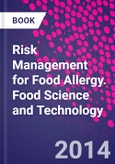Risk Management for Food Allergy is developed by a team of scientists and industry professionals who understand the importance of allergen risk assessment and presents practical, real-world guidance for food manufacturers.
With more than 12 million Americans suffering from food allergies and little indication of what is causing that number to continue to grow, food producers, packagers and distributors need to appropriately process, label and deliver their products to ensure the safety of customers with allergic conditions. By identifying risk factors during processing as well as determining appropriate "safe" thresholds of ingredients, the food industry must take increasingly proactive steps to avoid direct or cross-contamination as well as ensuring that their products are appropriately labeled and identified for those at risk.
This book covers a range of critical topics in this area, including the epidemiology of food allergy, assessing allergen thresholds and risk, specifics of gluten management and celiac disease, and much more. The practical advice on factory risk management, catering industry practices, allergen detection and measurement and regulatory controls is key for food industry professionals as well as regulators in government and other public bodies.
Please Note: This is an On Demand product, delivery may take up to 11 working days after payment has been received.
Table of Contents
Section 1: Food Allergy: causes, prevalence and impactsChapter 1: Living with Food Allergy: Cause for concern Chapter 2: Which foods cause food allergy and how is food allergy treated? Chapter 3: The Epidemiology of Food Allergy Section 2: Allergen thresholds & risk assessment
Chapter 4: How to determine thresholds clinically Chapter 5: Thresholds or "how much is too much" Chapter 6: From hazard to risk
Assessing the risk Section 3: Risk management of gluten
Chapter 7: Coeliac disease and risk management of gluten Section 4: Practical food allergen risk management
Chapter 8: Food Allergen Risk Management in the Factory
from ingredients to products Chapter 9: Managing food allergens. Case histories and how they were handled Chapter 10: Catering
how to keep allergic customers happy and safe? Chapter 11: Food Allergen Risk Management in the United States and Canada Chapter 12: The importance of food allergy training for Environmental Health Service professionals Chapter 13: Detecting and measuring allergens in food Chapter 14: Effect of Processing on the Allergenicity of Foods Chapter 15: Communication with Food Allergic Consumers: A Win-Win Experience Chapter 16: May contain
to use or not? Chapter 17: Regulatory Controls for Food Allergens Chapter 18: Keeping updated








